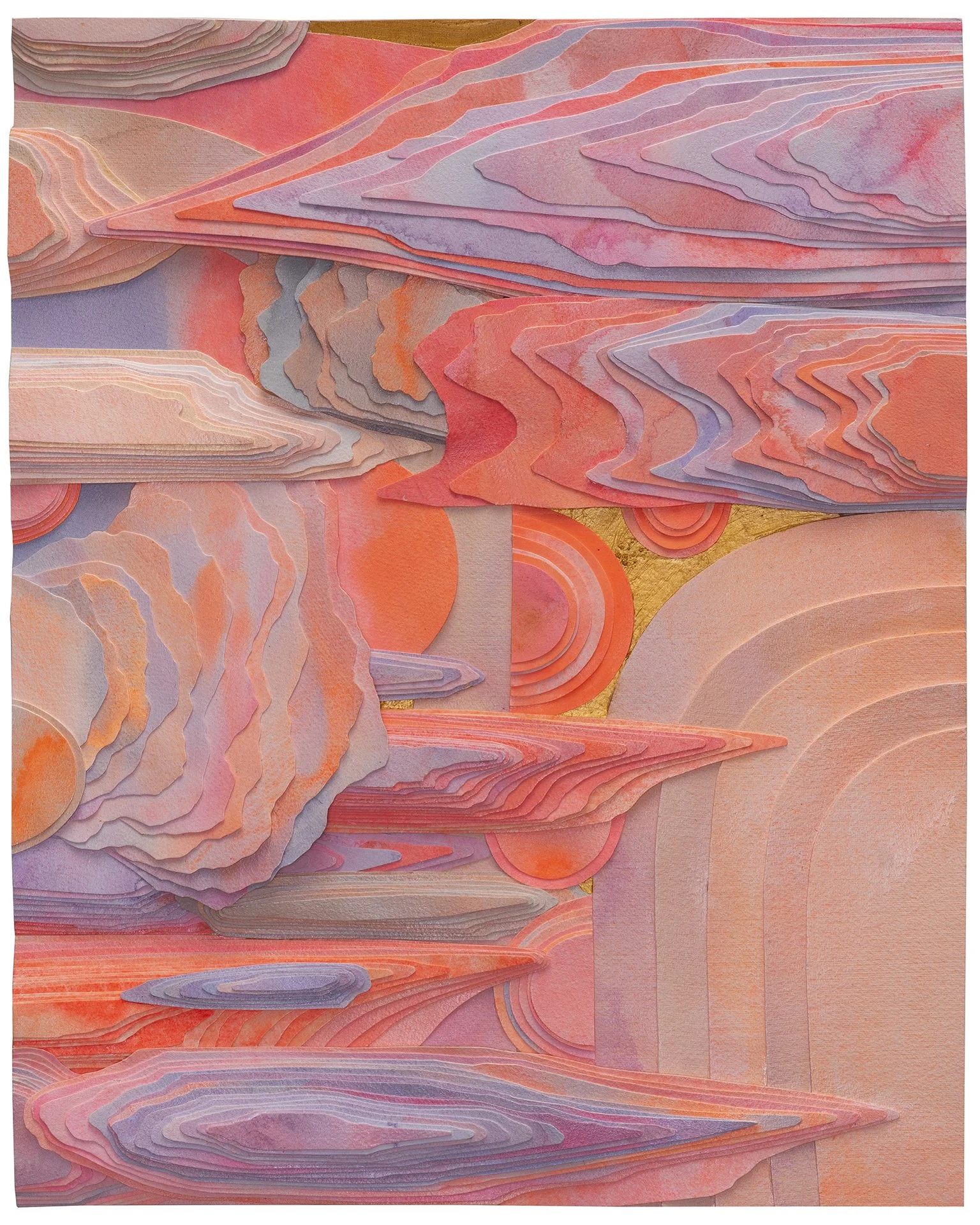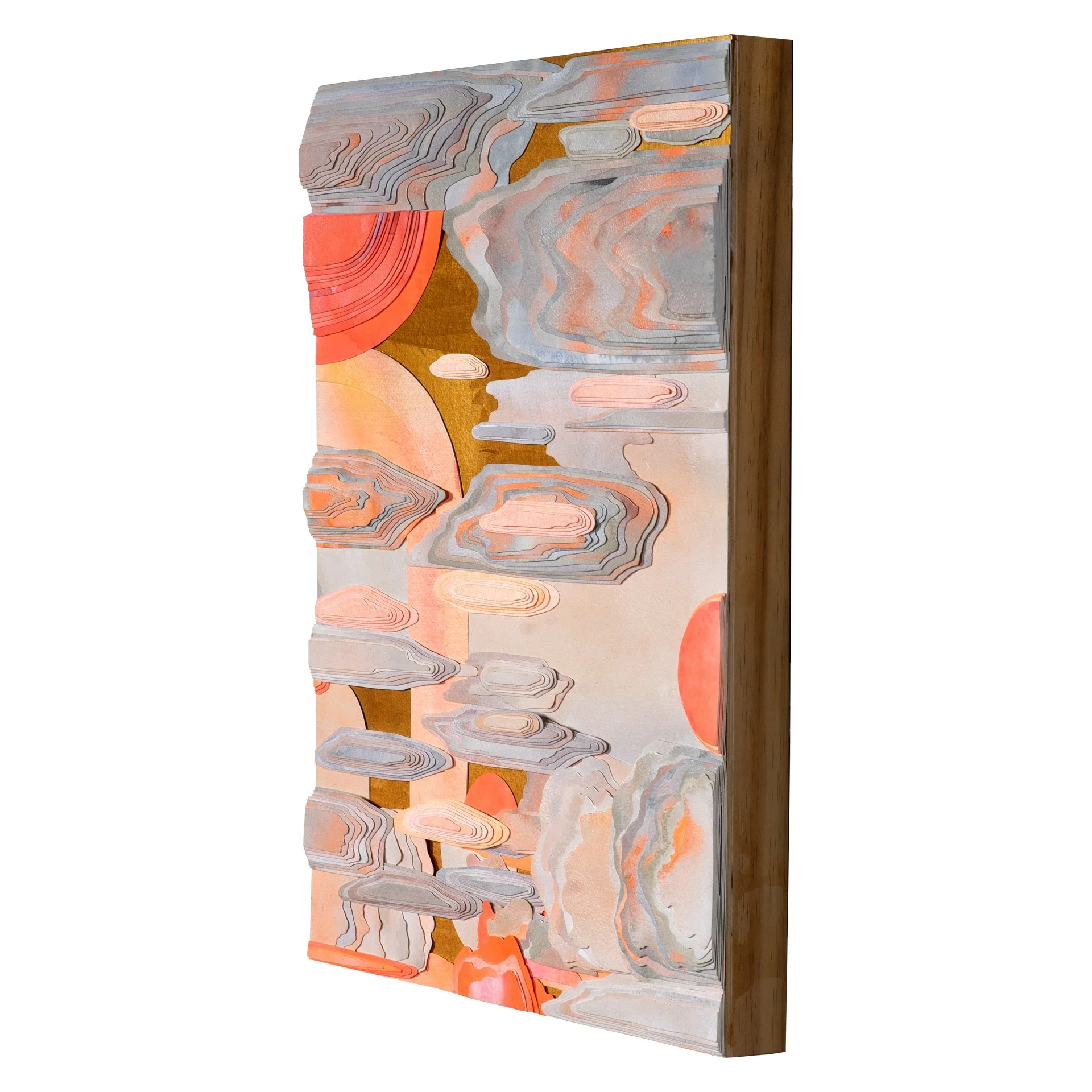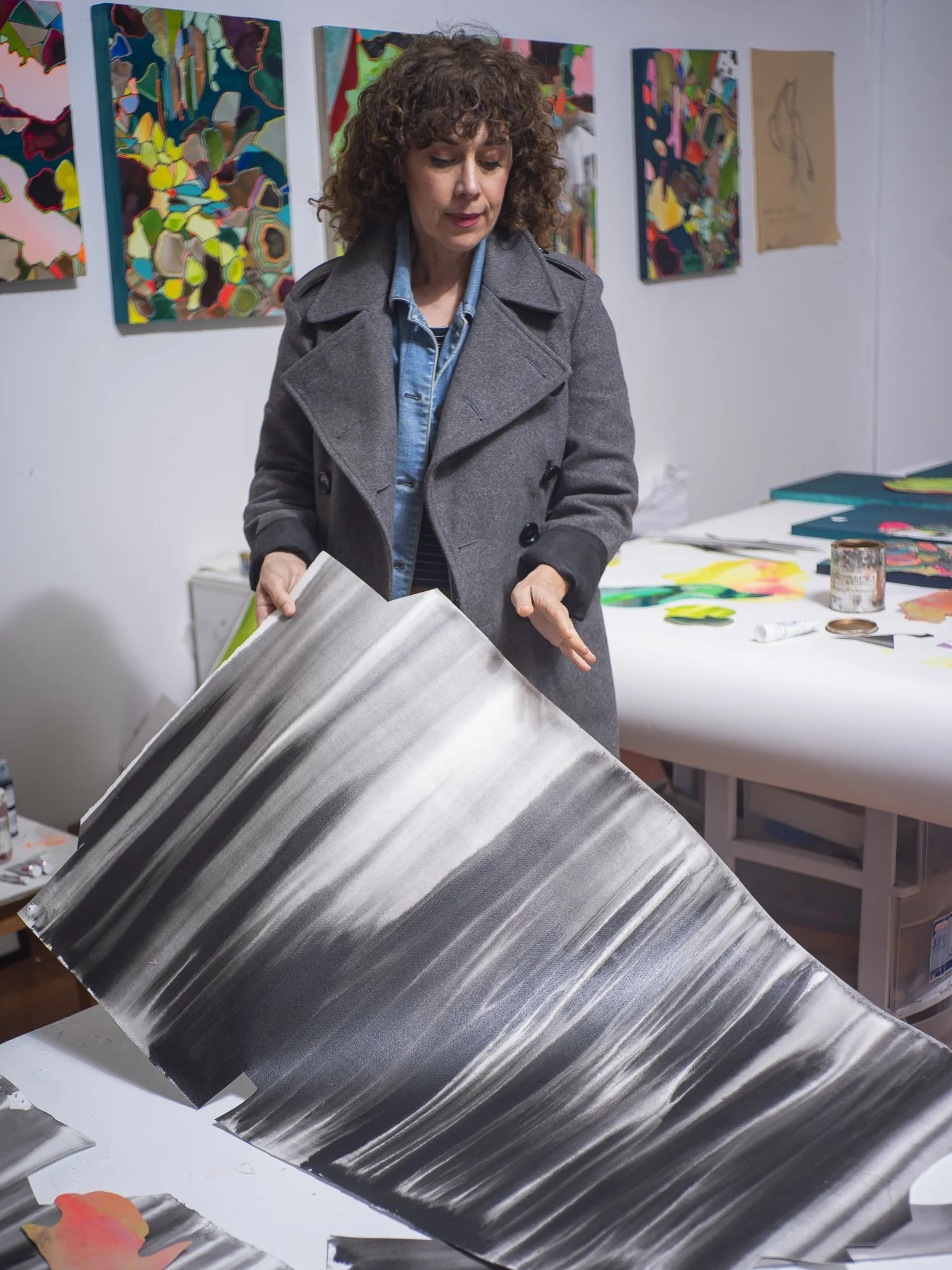Studio Visit & Interview With Carolynn Haydu
Interview and Photographs by Brandon Joseph Baker
I met Carolynn Haydu on a day trip with several other artists from the East Bay to Minnesota Street Projects in San Francisco. She spoke softly albeit confidently about her art over introductions. When I first saw her work in person a few weeks later, I was awestruck at the power contained in the intricately layered flow of colors. The canvas felt like a slice of marbleized energy. Stacks of painted paper created pools, plateaus, canyons and rolling hills with color. Carolynn said watching the landscapes pass outside the window on flights from her hometown of Los Angeles to her chosen home in The Bay Area helped inform her Topographic Works. The view from the plane was the perfect painting she wanted to make.
Carolynn studied Renaissance drawing technique at UC Berkeley before finishing a masters in Abstract Painting at NYU. Her education permeates her approach to color, rhythm, materials and texture. Yet there’s a nonacademic natural free spirit inside the compositions, full of unexpected turns in composition and hue. Carolynn’s abstract landscapes are expressions of her experiences outdoors. Much like in cubism where multiple perspectives of an object are shown, Carolynn’s landscapes delineate the energy she sees, hears and smells. Energy comes from being present in the environment, colors come from scents and sounds. In the studio she layers the energy back to the canvas through poured paint and stacked paper.
Carolynn’s work is not limited to abstractions. Her portraits feature pencil drawings and acrylic paintings with acutely accurate renderings of her subject’s likeness while the personality manifests as layers of color on paper and narrative symbols. All of Carolynn’s art is immersive. I’ve seen and photographed her work on multiple occasions yet continue to discover exciting nuances and depth every time I see them.
Interview
Thank you for opening up your studio space and for speaking with me about your process and art. Having a chance to ask probative questions about the art I’ve found so inspiring over the last two years is an honor. What is the strongest driving force that gets you into the studio to make art?
The drive to get into the studio is motivated by an idea rattling around my brain that won’t leave me in peace until I make it and put it in the world. It’s like an itch, or a longing. There is a river of energy that wants to find a way into the world and needs me to open the door.
How would you define or classify your art?
I classify myself as a mixed media painter. I hand paint paper, cut it up and reconfigure it onto wood panel. I layer the paintings so the two dimensions of the panel expand into three dimensions.
Where did the inspiration for your Topographic Works come from?
The inspiration for the topographic works came from an extremely boring meditation retreat in Big Sur. I found myself staring at the wood grain of the chair in front of me, unable to really drop into the meditation of it all. I realized while looking at the pattern, the basic design of wood grain is interchangeable with that of clouds, granite, waves and many patterns in nature. I realized there is a basic rhythm which connects all form in nature. I wanted to see if I could harness that rhythm in my work.
I also found inspiration from my brother’s topographical maps of California. He was an archeologist who spent time in wilderness and backcountry. We lost him to cancer two years ago. I like to think there is a piece of him in my work when I explore the theme of topography and California’s open spaces in my work.
‘Desert Dusk’ 16×20 paper on wood panel
“Silk Dusk” 16×20 Paper on wood panel
While studying for your Masters at NYU you spent time in Venice, Italy. Can you tell me about what you set out to achieve at the beginning of that portion of your education and what you still apply to your art now?
I don’t know what I set out to achieve. I knew I wanted to grow and expand as an artist. I didn’t know what form that would take. I knew going abroad would expose me to other ways of working, other sensibilities. At the end of my time in Venice, I ended up interested in a completely different aspect of art than when I entered the program. I began to be a process based artist. Instead of charting a piece ahead of making it, I turned into an artist that lets the materials lead the way.
You have a deep affinity with a very specific paper for your art. What is the paper and why is it a constant in your work?
I use Arches hot press watercolor paper. I have been using this paper for over 20 years. At UC Berkeley, we used this in our drawing classes because we could practice drawing with washes and dyes and the paper would not tear or degrade. I’m a loyal customer.
I absolutely love your work “Bolinas Ridge Trail”. The title suggests a very specific topographic area, however your work isn’t a literal translation of a landscape. What are you depicting in “Bolinas Ridge Trail” and how do you go about getting the inspiration for a piece like this?
I am depicting the ecstatic energy that I feel emits from the land in that area of California. At the risk of sounding “New Age-y” or “Woo-Woo”, I feel like there are open spaces in California that emit a very strong creative energy. I like to soak up that energy and use it to make paintings. “Bolinas Ridge Trail” is a picture of my experience walking through the land, swimming in the ocean, driving over the hills, and flying over this area of California. I wanted to depict all of those experiences simultaneously in this piece.
“Bolinas Ridge Trail”
The Topographic Works have a deep, vibrant and powerful color palette, where do you find the inspiration for these colors and how do you recreate them on paper?
I am looking at the jewel tones that one finds near the ocean, in tide pools, rocks and seaweed. I’m also looking at the color palette of artists like Raphael Balme, Haroshi and Cindy Phenix.
You’re from Los Angeles originally, what brought you to The Bay and what do you find keeps you here?
I have always been drawn to the Bay Area but I came here specifically to attend UC Berkeley. I stay because I think it still strikes the right balance of beauty, grit, and cool. Los Angeles is infinitely more cool but the Bay Area allows for an expansiveness that LA does not. LA puts on airs and fronts hard. I just can’t be bothered.
The narrative portraits you started in the pandemic, Dragon Girls and The One Who Knows, break the mold of your abstract work and feature subjective themes with beautifully drawn animals, hands and faces. Yet your layering of paper has a direct tie back into what you’re doing with the rest of your art. Can you tell me a little more about this series and what you gain artistically from blending these two styles of work?
I have worked in restaurants in the East Bay for over 20 years. When Covid 19 exploded into a pandemic, my community, like many, was hit hard. We lost our jobs overnight. I started making portraits of my friends in the restaurant industry. It was a project that I could channel my extra time and the build up of anxiety. I wanted the portraits to have an element of magical realism. The aim was to create pictures of my friends that celebrated their power and mystery at a time when many of us felt a bit helpless. The narrative is essential in this portrait series. I hadn’t worked with narrative in years because my work had taken a distinctly abstract turn which didn’t use explicit story telling. With the portrait project, I reconnected with drawing, stories, imagination and combined that with all I had learned in my abstract practice. The portraits were enhanced by the mixed media element, and the mixed media element was brought to life with the drawings. It was very empowering for me to see that I could put it all together.
As an artist working out of The Loom in Oakland with a studio mate, Fernanda Martinez, and a cast of super talented artists in the building (David Polka, Lady Henze, Meghan Shimek, Jet Martinez and Chute Studio), what role does community play in your art?
I am incredibly motivated by the presence of other hard working serious artists. They teach me so much about how to be professional and take advantage of the opportunities around me. Being connected to this community of artists has absolutely strengthened my ties to the Bay Area community in general.
What’s up next for you this year?
I’m continuing to make work every day. I’m diving deep into my Topograhic series. I am preparing work that I hope will eventually be a solo show!




























